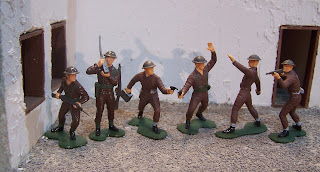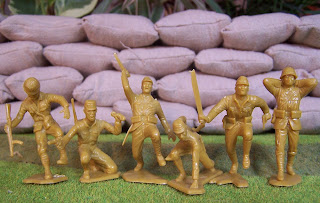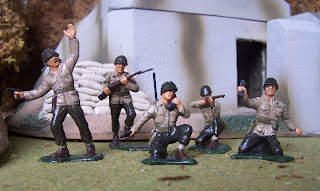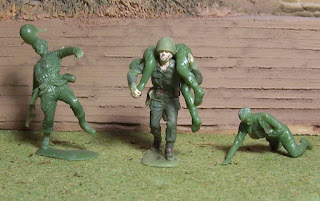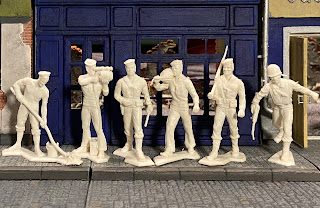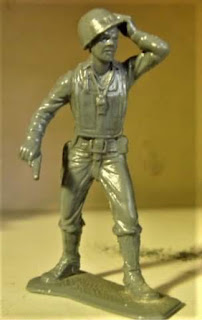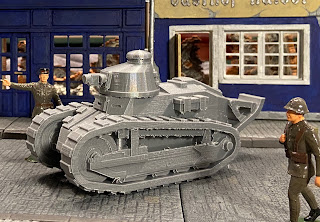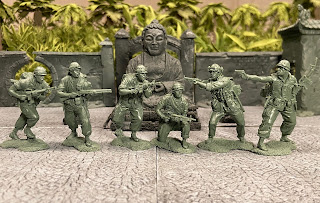Dedicated to exploring the world of Plastic Toy Soldiers. The focus is WWII figures & vehicles in 1:32 (54mm), although there's also a bit of Vietnam. If you grew up playing with them or simply love to collect them, this is the place for you. The posts are organized by Manufacturer & by Country/Service branch. Use the menu of labels on the right side of the blog to find what interests you. Comments are welcome. Please note that this site uses Google Analytics & AdSense cookies.
Google Analytics
Auto Ads
Search This Blog
Saturday, January 23, 2021
Marx - Toy Soldiers
Saturday, January 9, 2021
French Vehicles
Introducing the Renault FT-17 Tank
Known variably as Renault FT, FT17, FT-17, this is considered by many as the first modern tank because of its configuration: driver in the front, engine in the back, and the main weapon in the middle, hosted in a rotating turret. This became and remains the standard tank layout to this day. The Renault FT was designed in 1916 and initially produced in 1917, in the midst of WWI. The Renault FT was a departure of the initial armored behemoths of that conflict (like the Char 2C), changing the paradigm of armored warfare from one in which the tank acted as a supporting heavy weapon to one in which faster, smaller tanks were deployed in larger numbers to conduct a joint offensive. Not yet a-la Blitzkrieg, but an initial step in that direction. What's noteworthy is that even with its limited capabilities, this lighter, faster tank helped break the static warfare nature of WWI. The Renault FT's main gun was initially a heavy machine gun, but soon that upgraded to a 37 mm gun. It had a modest 39 hp engine, and a 95 lt (~24 gallon) fuel tank that gave it a 37 mile range at an average speed of 4.6 mph. This means that an average foot soldier could still out run it. It's armor ranged from 8mm to 22mm at the front, leading to a total weight of 6.5 tons. It was operated by a crew of 2. The driver and the commander, who also acted as the gunner. About 3000 made, mostly during last year of WWI, with the first FTs going into combat on May 1918. Many other countries adopted it during the interwar years, and several variations were made. However, by start of WWII newer tank models with greater speed, armor, and firepower had rendered the Renault FT-17 obsolete. Nonetheless, at the start of WWII this tank was found in the ranks of Poland, Finland, France, Greece, Romania and Yugoslavia. France had about 500 of them in mainland Europe, mostly for training purposes. After the early loss of most of their modern tanks, the Renaults had to be pressed into frontline service. Once Germany defeated France, they used the captured FT17s for security duties in the occupied territories. American forces encountered them in the battlefields of North Africa, in the hands of the Vichy French. The Japanese also faced them when they invaded the French colonies in Southeast Asia. In terms of models, our main vehicle producers (FOV, 21C) have not touched the subject, probably because of the limited role this tank played in WWII, but I recently found a 3D printed version of one. Let's take a look.
Wednesday, December 23, 2020
Introducing the US Ground Forces in Vietnam
The US armed forces in Vietnam included a wide range of units, including Army, Army Air Cavalry, Armor, Engineers, Marines, Airborne, Special Forces, Air Force, Navy Aviators, etc. While the US had been playing some type of role in the region since WWII, and throughout the Indochina war, the official start of the involvement for US forces in Vietnam is considered November of 1955, when the first set of sanctioned 'military advisors' was deployed on the ground to help train and administer financial aid.
The first two US casualties, who are also the first to appear on the Vietnam Memorial Wall, did not happen until 1959, when the VC attacked a US training camp. The first set of 400 Green Berets were sent in '61, anticipating that the fighting in Vietnam would require this type of small unit jungle warfare, and may not require large scale troop deployments.
By '63, the number of advisors had grown from a couple hundred to 16,000. Things escalated quickly after an incident in the summer of '64, during which a US Destroyer was attacked by North Vietnamese torpedo boats off the gulf of Tonkin as a result of which Congress authorized the US President to use military force as needed. Tactical retaliatory air strikes took place, and soon after they turned into a full blown bombing campaign against North Vietnam. Thus began Operation Rolling Thunder in March of '65 lasting through November of '68. Other air campaigns were organized to disrupt the logistical support flowing through the Ho Chi Minh trail destined for the VC and NVA troops fighting in South Vietnam.
The first contingent of 3500 Marines arrived in March of '65, and by that summer, fought their first major engagement against Viet Cong forces at the Battle of Van Tuong, decidedly defeating them. Later that year, about 3 battalions from of Air Cavalry Divisions faced the North Vietnamese Army for the first time in the Drang Valley in November '65, made famous in the book/movie 'We were soldiers once... and young". This battle was hard to call in favor of either side, but both sides claimed victory and reported very different casualty numbers.
From there, the US commitment of ground forces accelerated, relying on the draft to make the numbers. US troop presence peaked at abut 550k in the '68-'69 period. Additional troops from allied Asia-Pacific nations, funded by the US, were deployed. These came mainly from South Korea, with additional contributions from Australia, Thailand, Philippines, and New Zealand. These came mainly from South Korea, with additional contributions from Australia, Thailand, Philippines, and New Zealand. The number of US soldiers who fought in Vietnam is actually much higher (about 2.7 million - close to 1% of the US population at the time) given the fact that most of them served a one year tour of duty.
The US fighting tactics during the war relied heavily on the use of the helicopter and focused on 'search and destroy', which involved flying into areas where the enemy was suspected to be, finding them, destroying them, and then withdrawing. For many US troops, abandoning ground for which they had just fought and died was an odd concept. It also neglected the importance of winning the hearts and minds of the local villagers, which were heavily courted and pressured by the VC to join them. The task of dealing with the local population was left primarily to the South Vietnamese troops, which were apparently not very good at it.
US Air power was also used to deliver large loads of bombs, as well as herbicides and defoliants from 62 to 71. This was meant to deny the enemy the jungle cover that they relied on. The NVA and Viet Cong adapted by avoiding large scale engagements, and also going underground, relying on a large network of tunnels, that were also ideal for ambushing US troops searching for them. Most of the Vietnam engagements were small unit actions, fought in guerilla style ambushes, with many booby traps and trickery involved.
During '67 a series of engagements at the border region with Laos and the failed attempt by the NVA to lay siege to the Khe Sanh base overlooking the Ho Chi Minh trail made some US generals confident that the end of the war was in sight, or at least that's how it was communicated to the US public. The surprise Tet Offensive in January of '68 during a truce to observe the religious holiday shocked every one. The joint NVA and VC forces attacked every major city and town in the south. While initially successful, most objectives were back in US/South Vietnamese hands shortly - except for a few border regions and Hue, where control was not regained for over a month. And while VC losses were extremely high - about half their strength-, the psychological effect turned this into a positive outcome for the North. Even Saigon which had been deemed safe to that point was attacked and it took three days to reclaim it. It did not matter that the offensive had been repulsed and that the combined US/South Vietnamese losses were only a fraction of the enemy's. The Tet Offensive marked a turning point for the US. The public felt misled that the war was under control and support at home began to turn sharply. Soon after, the bombing campaigns were scaled back to just the DMZ zone, and the Paris peace talk began that spring. Events like the My Lai massacre in which approximately 400 civilians were killed by US forces during a search and destroy operation conducted in '68, further damaged the public's and the media's perception towards US involvement in Vietnam.
From that point forward, the US policy turned towards tuning over responsibility for operations to the South Vietnamese army, and the withdrawal of US forces. Between 80k to 180k US soldiers were withdrawn each year between '69 and '73. The Paris agreement of January and '73 made this official, and the US troops completed their withdrawal later that year, leaving behind plentiful amounts of planes, vehicles, weapons, ammunition, and other supplies. This was meant to prop up the South to be able to defend themselves on their own if needed. Hostilities between the North and the South almost immediately, but neither the US nor the international community had the appetite to engage militarily to enforce the agreement. Another Spring Offensive in March of '75 allowed the North to conclusively defeat the South. Saigon fell on April 30, 1975 putting an end to the Vietnam war. Total US casualties during the war were 58,220 KIA, 153,303 wounded, and approximately another 2,500 POW/MIA, which were unaccounted for at the end of the war. The number of South Vietnamese KIA is estimated at about a quarter of a million.
In terms of toy soldiers, this is a period that had not received much attention until recently. Perhaps because of how recent the war was as well as the controversy on the home front surrounding it. For decades, the only set depicting Vietnam troops had been the TimMee GIs. Fortunately for the Toy Soldier Collectors, the late 2010's have brought a nice number of sets onto the market by firms such as TSSD, Mars, and Plastic Platoon. Let's take a look.
